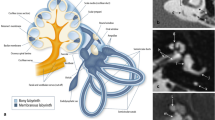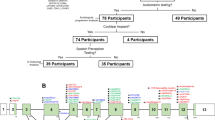Abstract
Present prospective study was conducted on 350 patients presenting with chief complaints of impaired hearing and delayed speech from 1996–2006. The aim of the present study was to find out the prevalence of deafmutism in our area, the aetiology of childhood deafness and to ascertain the role of acoustic reflex test (ART) for hearing screening considering brain stem evoked response audiometry (BSERA) as gold standard. A detailed history, clinical and other relevant systemic examination and investigations were done to find out the cause. All patients were subjected to ART test and BSERA. Male to female ratio was 2.1:1. Prevalence was found to be 5.59 per one lac population in our district. The commonest age of presentation was in the second decade. The causes for childhood deafness were genetic (15.8%), embryopathies (10%), perinatal (10.8%) and postnatal problems (12.5%). In 50.6% cases it was aediopathic. Congenital syndromic abnormalities were found in 5.4% patients. In BSERA 21% patients were found to have residual hearing varying from 60 dB to 100dB. The positive predictive value of ART was found to be low (10.4%). Hence it was recommended that ART should not be used as screening tool for childhood deafness.
Similar content being viewed by others
References
Joint Committee on Infant Hearing. Year 2000 Position Statement: Principles and Guidelines for Early Hearing Detection and Intervention Programs. Am J Audiol 2000; 9(l):9–29
Walger M, Hörstörungen, Hörbahnreifung. über die Bedeutung der Früherkennung und Therapie kindlicher Hörstörungen. Hörbericht 2000; 67:1–7
Kiese-Himmel C, Ohlwein S (2000) Die Sprachentwicklung sensorineural hörgestörter Kleinkinder. Sprache Stimme Gehör 24(4):169–76
Markides A (1986) Age a fitting of hearing aids and speech intelligibility. Br J Audiol 20(2):165–167
Thorantan ARD (1981) Computer stimulation of ABR in different pathologies. Sensus 1:71–75
Chippa KH (1983) Evoked potentials in clinical medicine, NewYork, Reven press, 138–180
Lyn C, Jadn Singh WA, Ashman H, Chen D, Abramson A, Souter (1998) Hearing screening in Jamaica: prevalence of otitis media with effusion. Laryngoscope 108(2):228–290
Ballot DE, Rothberg AD, Katz BJ (1992) Speech and hearing problem in high-risk population. South African Journal 82(1):23–26
Rao ABN (1986) Middle ear problem in Australian aboriginals. Indian journal of otolaryngology 38(l):6–8
Schein JD, Delk MT. The deaf population of the United States. Silver Spring, MD: National Association of the Deaf
Kankkunen A (1982) Preschool children with impaired hearing. Acta Otolaryngolica Suppl 391:1–124
Watkin PM, Baldwin M, Laoide S (1990) Parental suspicion and identification of hearing impairment. Archives of Disease in Childhood 65:846–850
Kumar S, Chaturvedi UN (1996) Facilities for speech and hearing in school for hearing handicapped in Wardha district, India. Hearing international 5(2):7
Fraser GR, Froggatt P, James TN (1964) Congenital deafness associated with electrocardiographic abnormalities, fainting attacks and sudden death. Quart J Med 33:361–385
Strauss M (1990) Human cytomegalovirus labyrinthitis. American Journal of Otolaryngology 11:292–329
Martin JAM (1982) Aetiological factors relating to childhood deafness in the European community. Audiology 21:149–158
Davis AC, Wood (1992) The epidemiology of childhood heavy impairment: Factors relevant to planning of services. British Journal of Audiology 26:77–90
Fortnum H, Davis A, Butler A, Stevens J. Health Service implications of changes in aetiology and referral patterns of hearing-impaired children in Trent 1985–1993. Medical Research Council Institute of Hearing Research, Nottingham, United Kingdom
Bergman L, Hirsch RP, Fria T J, Shapiro SM, Holzman I, Painter M J (1985) Cause of hearing loss in the high risk premature infant. Journal of pediatrics 106:95–101
Bellman S, Vanniasegaram I (1997) Testing hearing in Children. In, Adams DA, Cinnamond MJ (ed). Scott Brown Otolaryngology, Vol 6, 6th edition. Oxford: Butter Heinemann, 11–12
Jerger J, Burney P, Mauldin L, Crump B (1947b) Predicting, hearing loss from the acoustic reflex. Journal of Speech and Hearing Disorders 39:1–11
Niemeyer W, Sesterhenn G (1974) Calculating the hearing threshold from the stapedius reflex threshold for different sound stimuli. Audiology 13:421–427
Author information
Authors and Affiliations
Corresponding author
Rights and permissions
About this article
Cite this article
Singh, M., Gupta, S.C. & Singla, A. Assessment of deafmute patients: a study of ten years. Indian J Otolaryngol Head Neck Surg 61, 19–22 (2009). https://doi.org/10.1007/s12070-009-0027-3
Published:
Issue Date:
DOI: https://doi.org/10.1007/s12070-009-0027-3




